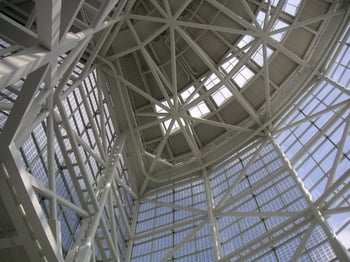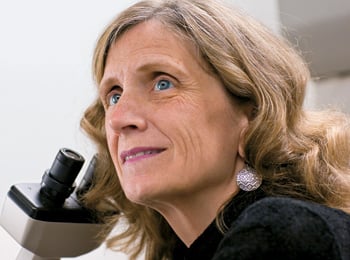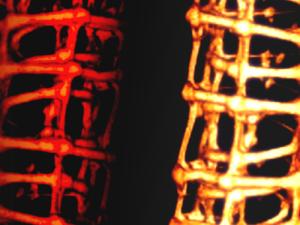 Researchers from the Washington State University School of Pharmacy have recently uncovered a previously unknown function of a protein called Activating Transcription Factor 5 (ATF5).
Researchers from the Washington State University School of Pharmacy have recently uncovered a previously unknown function of a protein called Activating Transcription Factor 5 (ATF5).
Tags: Washington, WSU Pullman, WA, cancer research, cell biology, WSU, Washington State University, Biology, 2015, Pharmacy, Northwest Region, Pullman, BioResearch Product Faire™
 The tighter funding gets, the more likely it is that young investigators pursuing big ideas will get passed over and science grant money will stay with safer, more established projects. Fortunately there are exceptions to that general rule, including a new program established by the Paul G. Allen Family Foundation specifically to support select pioneering research projects that aim to unlock fundamental questions in biology. They recently awarded investigators from 5 prestigious US universities a total of $7.5M to pursue basic questions about the origins and mechanisms of cellular behavior. One of those 5 Distinguished Investigator awards, for $1.6M, is going to quantitative biologist and recent hire Suckjoon Jun, who works in physics and molecular biology at the University of California San Diego. His project title is "Cell-size control and its evolution at the single-cell level," and includes developing methods to perform long-term directed single-cell evolution experiments, as well as single-cell on-chip manipulation, sequencing, and mathematical modeling.
The tighter funding gets, the more likely it is that young investigators pursuing big ideas will get passed over and science grant money will stay with safer, more established projects. Fortunately there are exceptions to that general rule, including a new program established by the Paul G. Allen Family Foundation specifically to support select pioneering research projects that aim to unlock fundamental questions in biology. They recently awarded investigators from 5 prestigious US universities a total of $7.5M to pursue basic questions about the origins and mechanisms of cellular behavior. One of those 5 Distinguished Investigator awards, for $1.6M, is going to quantitative biologist and recent hire Suckjoon Jun, who works in physics and molecular biology at the University of California San Diego. His project title is "Cell-size control and its evolution at the single-cell level," and includes developing methods to perform long-term directed single-cell evolution experiments, as well as single-cell on-chip manipulation, sequencing, and mathematical modeling.
Tags: 2014, CA, University of California San Diego, 2013, cell biology, Southwest, California, University of California, Cell Research, San Diego, SDVS, Funding, UCSD, Biotechnology Vendor Showcase
Lab scientists at the University of Pittsburgh Cancer Institute and UP's Center for Biologic Imaging have recently published an important paper in the Journal of Cell Science that sheds light on a novel method of interrupting mitosis in a cell by effectively depriving its mitochondria of a key protein. The resulting replication stress means cancer cells are stopped from successfully multiplying. Colorful images of the targeted cells actually show them stuck in anaphase trying to divide and subsequently tearing themselves apart. By identifying a compound that carries out this protein interference and disrupts normal mitochondrial fission, researchers have identified a promising therapeutic avenue for halting cancer growth.
Tags: 2014, 2013, University of Pittsburgh, Pennsylvania, Northeast, Hillman Cancer Center, cancer research, cell biology, Microscopy, UPITT, Cell Research, BioResearch Product Faire Event, PA, NIH, Pittsburgh, Northeast Region
 If Dr. Seuss were still writing his wonderous books and turned his attention to biotechnology today, we might see a title like Ah, the Things You Can Do With Algae! At the University of California San Diego a number of research institutions have joined together to form the San Diego Center for Algae Biotechnology (SD-CAB) where scientists are pursuing all sorts of innovative projects using the ubiquitous green matter that also happens to be a genetic model organism. Which means it is not only easy to grow, but it can do things that bacteria and even mammalian cells can't, like host a genetically engineered protein that targets cancer.
If Dr. Seuss were still writing his wonderous books and turned his attention to biotechnology today, we might see a title like Ah, the Things You Can Do With Algae! At the University of California San Diego a number of research institutions have joined together to form the San Diego Center for Algae Biotechnology (SD-CAB) where scientists are pursuing all sorts of innovative projects using the ubiquitous green matter that also happens to be a genetic model organism. Which means it is not only easy to grow, but it can do things that bacteria and even mammalian cells can't, like host a genetically engineered protein that targets cancer.
Tags: CA, University of California San Diego, cancer research, cell biology, Southwest, California, 2012, biology research, UCSD, Biotechnology Vendor Showcase, San Diego Biotechnology
 Dr. J. Lee Nelson (right) has been studying the fascinating phenomenon of microchimerism in the context of autoimmune disorders ever since she joined the Fred Hutchinson Cancer Research Center faculty in 1986. Microchimerism refers to the presence of two distinct sets of cells in one individual and is surprisingly common as a result of cell exchange between mother and child during pregnancy. The numbers of these outside cells is typically small, but Dr. Nelson's research has implicated them in various autoimmune responses, both positive and negative.
Dr. J. Lee Nelson (right) has been studying the fascinating phenomenon of microchimerism in the context of autoimmune disorders ever since she joined the Fred Hutchinson Cancer Research Center faculty in 1986. Microchimerism refers to the presence of two distinct sets of cells in one individual and is surprisingly common as a result of cell exchange between mother and child during pregnancy. The numbers of these outside cells is typically small, but Dr. Nelson's research has implicated them in various autoimmune responses, both positive and negative.
Tags: Fred Hutchinson Cancer Research Center, Washington, Northwest, cell biology, 2012, Cancer, Cell Research, autoimmune disease, Canada, Seattle, Biotechnology Vendor Showcase
 The word antibacterial is popping up on more and more household items as merchandisers find that consumers generally believe that chemicals designed to kill bacteria are a useful additive to a product and boost its appeal. Very often the chemical that's added is one called triclosan, and according to recently published research by a team of University of California Davis biomedical scientists, the common polychloro phenoxy phenol causes muscle impairment in animal and lab tissue models. Specifically, it limits the ability of the muscle to expand and contract. A beating heart is one example.
The word antibacterial is popping up on more and more household items as merchandisers find that consumers generally believe that chemicals designed to kill bacteria are a useful additive to a product and boost its appeal. Very often the chemical that's added is one called triclosan, and according to recently published research by a team of University of California Davis biomedical scientists, the common polychloro phenoxy phenol causes muscle impairment in animal and lab tissue models. Specifically, it limits the ability of the muscle to expand and contract. A beating heart is one example.
Tags: CA, University of California Davis, cardiovascular research, chemical research, cell biology, California, 2012, animal science, chemistry research, BioResearch Product Faire Event, Davis, Sacramento Campus, UCD
 It's getting to the point where there's less and less relevant distinction to be made between life science and physical science research. It was clearer when one lab had petri dishes and the other had circuitboards, but what happens when you have both? That's the case in the Harvard University labs of chemist Charles Lieber and his medical school colleague Daniel Kohane, where the bio research team has successfully created living tissue embedded with tiny nanowires capable of running an electrical current so subtle that it does not harm the tissue cells. These 3D bioelectronic structures could potentially both relay complex information about what's going on inside the tissue and receive signals from an outside source such as instructions for repairs. Several news outlets are calling it cyborg tissue and envision its future use in implants, prosthetics, or even some kind of therapeutic microbot. More immediately it will most likely be used for drug testing in labs, as a precursor to animal or human trials.
It's getting to the point where there's less and less relevant distinction to be made between life science and physical science research. It was clearer when one lab had petri dishes and the other had circuitboards, but what happens when you have both? That's the case in the Harvard University labs of chemist Charles Lieber and his medical school colleague Daniel Kohane, where the bio research team has successfully created living tissue embedded with tiny nanowires capable of running an electrical current so subtle that it does not harm the tissue cells. These 3D bioelectronic structures could potentially both relay complex information about what's going on inside the tissue and receive signals from an outside source such as instructions for repairs. Several news outlets are calling it cyborg tissue and envision its future use in implants, prosthetics, or even some kind of therapeutic microbot. More immediately it will most likely be used for drug testing in labs, as a precursor to animal or human trials.
Tags: Northeast, MIT, cell biology, 2012, Biochemistry, Massachusetts, biorobotics, Cell Research, chemistry research, bioprinting, Boston, BioResearch Product Faire Event, MA, Harvard, Harvard Medical School
 Oregon State researchers recently discovered DNA in a nematode, a type of roundworm, that may provide an insight into the mechanisms of human aging. The researchers found a specific portion of DNA within the mitochondria of the nematode which displayed the characteristics of "selfish" DNA, in other words, DNA which actually hurts the animal's chances of survival. Scientists have previously found instances of selfish DNA occurring in plants, but this is the first example found in an animal. “We weren’t even looking for this when we found it, and at first we thought it must be a laboratory error,” said Dee Denver, Oregon State associate professor of zoology (photo left courtesy of OSU). "Selfish DNA is not supposed to be found in animals."
Oregon State researchers recently discovered DNA in a nematode, a type of roundworm, that may provide an insight into the mechanisms of human aging. The researchers found a specific portion of DNA within the mitochondria of the nematode which displayed the characteristics of "selfish" DNA, in other words, DNA which actually hurts the animal's chances of survival. Scientists have previously found instances of selfish DNA occurring in plants, but this is the first example found in an animal. “We weren’t even looking for this when we found it, and at first we thought it must be a laboratory error,” said Dee Denver, Oregon State associate professor of zoology (photo left courtesy of OSU). "Selfish DNA is not supposed to be found in animals."
Tags: Oregon State University, Aging, Northwest, cell biology, Oregon, 2012, Cell Research, Genomics, Genetics, current science events, Front Line event, OR, Corvalis, ORSTU, oregon research
Given that the ubiquity of sweat glands over the surface of the body is such a defining aspect of human physiology (and evolution), it's a wonder how little basic research has been done to understand how they work at the cellular level. Until Rockefeller University cell biologists published their recent findings in Cell, we didn't even know if sweat glands had unique stem cells. It turns out they do. The study also demonstrated that, while sweat glands are close cousins to mammary glands, adult stem cell activity is markedly different in the two systems (though they have a common progenitor), and in fact that there are four separate stem cell types that regulate maintenance and repair of glands and their epidermal-level counterparts throughout our lives.
Tags: Rockefeller University, Northeast, Stem cell research, cell biology, New York, 2012, Cell Research, bio research, BioResearch Product Faire Event, NY, New York City

